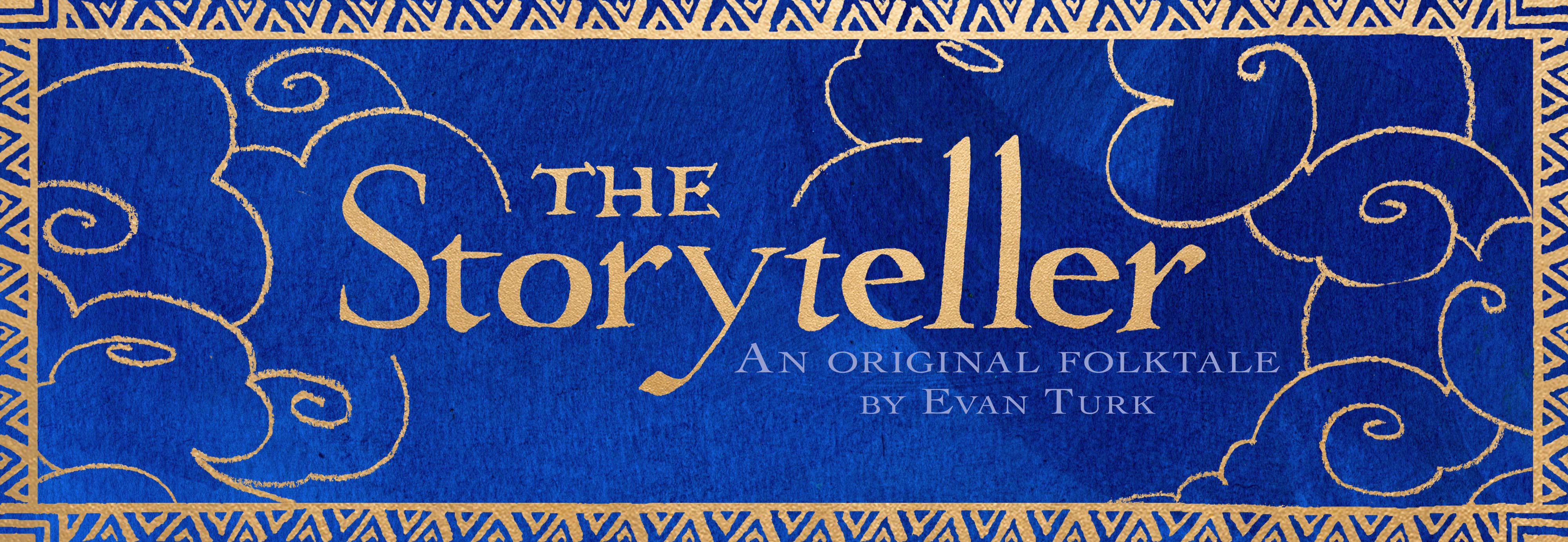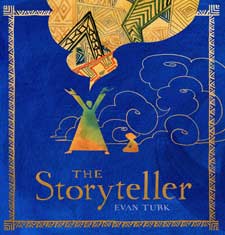The Art of ‘The Storyteller’: Influences
The style of the artwork in The Storyteller evolved over a long time, incorporating many different influences along the way. In this post, I’ll focus on a few of these influences and how they are reflected in the art throughout the book.
Gustav Klimt
Read MoreStorytelling Celebrated as Life-giving Force

The art of storytelling is celebrated as a life-giving force in this enthralling picture book set in Morocco.
–
A nameless, thirsty boy meets a storyteller and is drawn to return day after day to listen to intricately linked stories and to learn the older man’s art. The stories bring not only sustenance to the boy’s inner life, but water to his lips, for in this world, storytelling and water are symbolically connected. Stories will ward off the great drought if the Sahara encroaches on the cities, but only if young people keep the tradition alive. And so, in the manner of Scheherazade, the stories unfold, and the protagonist retells the story of the boy who saved the city from the sandstorm that arrived as a large djinn by telling him a story, day by day. With the stories embodying sharing, creativity, and hope, the life force of cool blue water appears in the illustrations, the antithesis of the destructive brown sand. Beautiful swirls of blue dominate many of the intricately bordered double-page spreads, fighting against the tans and browns of the djinn and the sands he represents. Each spread takes on a life of its own, sometimes highly geometric, other times full of swiftly crayon-drawn individuals, and still others with heavily inked and outlined figures.
–
Original storytelling with the feel of the best folklore, enhanced by illustrations done in a style not seen anyplace else. —Kirkus Reviews, Starred Review
Visually Stunning

Elizabeth Bird of School Library Journal reviewed The StoryTeller (Atheneum Books for Young Readers) in an article for Fuse 8 Production.
Read More“It seems odd to say, but this book, wrapped as it is in classic motifs and themes dating back hundreds, even thousands, of years, is one of the freshest, most timely picture books I’ve had the honor to read in a long time. Visually stunning with a storyline to match, Turk is beginning to make good on his talents. This is a man with storytelling in his blood and bones. Our children reap the rewards. A can’t miss book.”
—Elizabeth Bird, School Library Journal
Diverse Books: Setting Deeply Purposeful

Elizabeth Bird of School Library Journal considers The Storyteller (Atheneum Books for Young Readers) in the current discussion of representation and diverse books in an article for Fuse 8 Production.
“There’s been a lot of discussion lately about diversity in children’s literature. Specifically, some of that discussion has concerned those books written by white people about other cultures. It’s not a new phenomenon but what is a bit new is the increasing understanding that if you are going to use another culture, you need to do your homework.
If, for example, you are setting a story in Morocco, then you need to make the readers understand why you made that choice. That it wasn’t arbitrary. This is yet another of the many reasons I’m so impressed with Turk’s work here. That he sets his story in Morocco (contemporary Morocco, by the look of it) is deeply purposeful.
The Author’s Note at the end explains further. From this we learn that Morocco’s public storytellers or hlaykia have told tales for “nearly one thousand years” and yet “Only a handful of master storytellers remain”. All is not lost, though. Renewed interest in storytelling has surfaced, specifically at a restaurant called Café Clock in Marrakech. Turk then closes with a small Bibliography of sources on everything from storytelling to carpet weaving.
The book then is not an appropriation of an “exotic” culture done on a whim but rather a considered, thoughtful selection that serves as an ideal setting for a tale about storytelling then, now, and in the future.”
Read More
Carpets and Borders: Look for Blue Glimmer of Hope
The borders and patterns of The Storyteller (Atheneum Books for Young Readers) have much to say about the stories themselves, and all come from traditional Moroccan carpet patterns.
Elizabeth Bird of School Library Journal follows the diamonds in The Storyteller in an article for Fuse 8 Production.
“Look for a blue glimmer of hope to appear around each story!” —Evan Turk
“…after each story’s text a diamond appears. However, as the stories appear within stories within stories, the diamonds grow more elaborate and decorative. Then, as the stories end one by one, the diamonds simplify once more.
I began searching the art for more diamonds and here Turk doesn’t disappoint. If you look closely at the borders of the book, you see that the diamonds appear when there is hope and fade from blue to brown diamonds when hope dries up. As the storytelling increases the borders fill in more and more blue, just as the townspeople fill their fountains with bowl after bowl of water. Point out to a child reader the diamond motif and you are sure to be surprised by all that they find hidden in these pages.”
—Elizabeth Bird, School Library Journal
Beyond the borders filling with blue as the stories progress, there is even more to look at!
Each story has its own border in its own color:
The Sandstorm and the Storyteller: Golden Yellow (turning indigo blue)
The Endless Drought: Green
The Glorious Blue Water Bird: Brown
The Miraculous Yarn: Black
The four colors are very common in Moroccan arts, and have been related to the life cycle of a ripening date (a common fruit from date palm trees around Morocco). The fruits begin green, turn yellow, then to brown, then to black. The colors are also mentioned in association with the colors of “henna”, which is used to decorate Amazigh bride’s skin in traditional wedding ceremonies. The leaves of the henna plant and the paste they make are green. When the paste is applied, it stains the skin black, then fades to reddish brown, then finally to yellow.
(Read more about the symbolism of Moroccan carpets in the article Amazigh Textiles and Dress in Morocco: Metaphors of Motherhood by Cynthia Becker)
Each pattern is taken from traditional Moroccan carpets, as are the patterns seen on carpets throughout the book. In the image at the top of this post, you can see several different stylized types of carpets from the Atlas region. See if you can spot them in the image!
(Images from Jemaia Tifawin: Weavers of the village of Anzal)
Patterns in Moroccan carpets can mean different things to different regions of weavers, and different things to each individual weaver. The meanings of the symbols also can change over generations, so there is no one “true” meaning that applies to a symbol universally.
The diamond/lozenge pattern can symbolize fertility and the womb. It can also be a symbol of protection against the “evil eye.”
The chevron pattern can also symbolize female fertility. The story of the boy and the storyteller is all about the creation of stories and their ability to protect. The nested tales in The Storyteller all center around women and creation.
 The zig zag pattern can symbolize a snake, an arrow, and male energy, and is often around the border of a carpet, with female symbols (like the female stories in the book) in the center.
The zig zag pattern can symbolize a snake, an arrow, and male energy, and is often around the border of a carpet, with female symbols (like the female stories in the book) in the center.
The triangle pattern can symbolize a snake or male energy, and is also mostly found around the borders, surrounding female symbols.
 The diamond/lozenge with hooked corners is sometimes called the “spider” (a symbol related to weaving) and can symbolize creation and birth, like the story of the escaped princess.
The diamond/lozenge with hooked corners is sometimes called the “spider” (a symbol related to weaving) and can symbolize creation and birth, like the story of the escaped princess.
Makes Readers the Tellers of Tales

Read More“The story of The Storyteller will make readers tellers of tales. Thus, the request for stories to quench our thirst will never dry up. Evan Turk’s illustrations are a visual play of story in itself as well.”
—Ashley Bryan, multiple Coretta Scott King Award winner

















